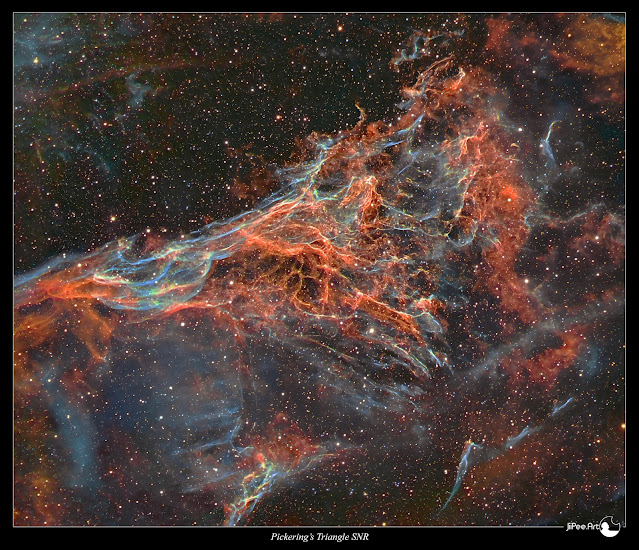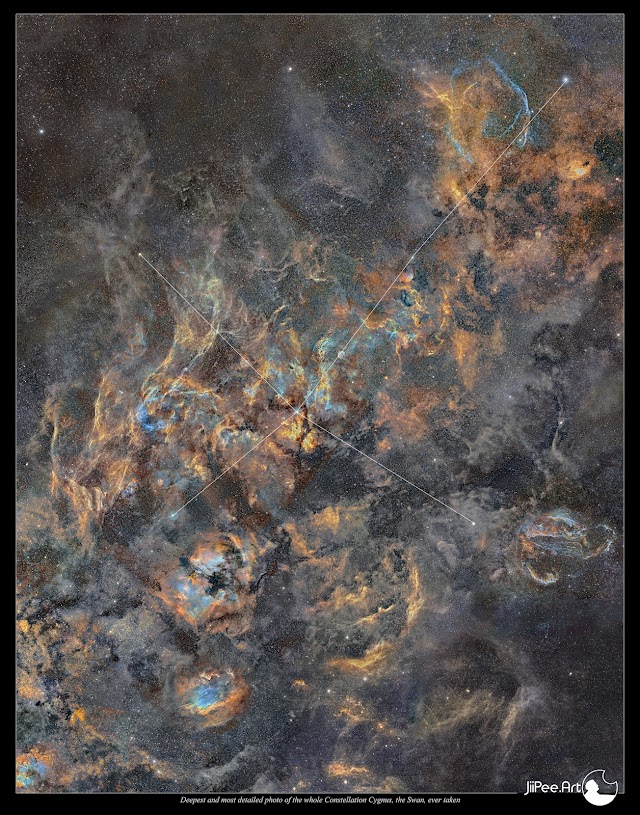COPYRIGHT, PLEASE NOTE
Tuesday, April 8, 2025
Strange Pillar like Formation in IC 1805, The Heart Nebula
This is an object in the Heart Nebula that I have captured from time to time. My previous photo was taken in 2012.
This new photo reveals more details, even though the exposure time for H-alpha light was only 5 hours.
The pillar-like formations are typically pointing toward a source of ionization, in this case, the more famous Melotte 15.
I haven't been able to find a name for this beautiful object
 A mapped color image from a light emitted by an ionized elements, sulfur=red, hydrogen=green and oxygen=blue. Original resolution 6500 x 6500 pixels
A mapped color image from a light emitted by an ionized elements, sulfur=red, hydrogen=green and oxygen=blue. Original resolution 6500 x 6500 pixelsO-III, 6x 1200 s, binned 2x2 = 2h
Sunday, March 30, 2025
A Fossil Footprint Nebula, NGC 1491
I have shot this emission nebula in Perseus several times during the years and every time felt that I got more out of it.
I have wide field and mosaic images including the NGC 1491 as well as longer focal length photos with various reflecting telescopes. Some of them are included in the blog post as an exampleClick for a much large image
Click for a much large image
O-III, 6x 1200 s, binned 2x2 = 2h
Wednesday, March 26, 2025
Soul Nebula, IC1848
Click for a large image, 2000 x 2000 pixels

Click for a large image, 2000 x 2300 pixels
Click for a large image, 4600 x 2000 pixels
Hearth and Soul Nebulae at upper right corner
O-III, 6x 1200 s, binned 2x2 = 2h
Monday, March 24, 2025
Melotte 15 in heart nebula, IC 1805
I shot material for this new photo back in February, 10 hours of exposures total for three narrowband color channels. (H-alpha, O-III and S-II)
Click for a large image, 2000 x 2000 pixels
Click for a large image, 2500 x 3200 pixels
O-III, 6x 1200 s, binned 2x2 = 2h
Monday, March 17, 2025
HFG1, a Planetary Nebula in Cassiopeia
I managed to get 17 hours of H-alpha light for the HFG1 and now I'm able to do color photo out of it.
This is a difficult target, very diffused and large, I tried to keep my processing kind of modest to bring out delectate nature of an old and dim planetary Nebula.
Total exposure time is 37 hours and signal wasn't the best possible but I'm happy with this result.
HFG1 in O-III light only
Click for a large image, 2000x2000 pixels
H-alpha, 51 x 1200 s = 17h
Saturday, March 8, 2025
NGC 281, a New Revision
I made a new composition out of my new NGC 281 material, the original composition and technical details can be seen here: https://astroanarchy.blogspot.com/2025/01/new-photo-of-ngc-281.html
This new poster format composition brings out the dynamic nature of this target better.
Click for a large image, 2000x2600 pixels
Thursday, March 6, 2025
A Very Deep View to my Soul, IC1848
This is a new photo of the Soul Nebula in Cassiopeia.
A total of 20 hours of H-alpha exposure, along with 6 hours of S-II and O-III combined, allows me to capture intricate details of this relatively bright astronomical cloud of gas and dust.
Click for a large image, 2100x2300 pixels
sulfur=red, hydrogen=green and oxygen=blue
Click for a full size, 2100x2300 pixels
O-III,21x 1200 s, binned 2x2 = 3h
A single calibrated 20 min exposure of H-alpha, Bin 1x1
Tuesday, March 4, 2025
HFG1, a Challenging Planetary in Cassiopeia
I have planning to shoot this dim, diffused and large planetary nebula for a long time. The imaging season up here 65N is over in few weeks since we'll loose astronomical darkness for six months due to high latitude.
So far I have collected about 20 hours of exposures of light emitted by a triple ionized oxygen, O-III
I think it's very beautiful as it now but I'll add H-alpha light when ever weather allows.
HFG1
Click for a large image, 2000x2000 pixels
Sunday, February 16, 2025
New Tool, a Powerful Dell Precision 7875 Workstation
Workstation computers from Dell are really well-built and come with excellent next-business-day onsite service. I have been using them for a couple of decades for my work. My previous workstation served me well for almost nine years—these kinds of computers do not age as fast as normal consumer PCs.
My old Dell workstation has two ten-core Xeon processors, 128GB of memory, and a decent graphics card. Since I work with 4K and 8K videos, 3D graphics, and run AI locally, my old workstation has become far too slow. It goes to my observatory computer, little overkill for telescope and camera control but works well there.
The new Dell Precision 7875 Workstation features a 96-core AMD Threadripper Pro processor (3.2 – 5.1 GHz), 512GB of RAM, and a 20GB NVIDIA RTX 4000 Ada graphics card. It comes with a standard three-year next-business-day onsite service in case anything goes wrong.
My new display is also from Dell—a 40-inch 21:9 curved Thunderbolt hub monitor with a stunning 5K resolution and a 120Hz refresh rate. The curve in the monitor is perfect for correcting perspective distortion, ensuring that straight lines remain visually straight.
I also use an Ergotron monitor arm, so no desk space is wasted, allowing me to position the large display at the optimal distance and orientation with ease
Thursday, February 6, 2025
Pickering's Triangle, Resurrection
This is not exactly a new image of Pickering's Triangle, but it is a completely new revision of it. I have photographed this complex-looking region of the Veil Nebula supernova remnant in Cygnus multiple times over the decades. In this latest revision, I have gathered all my exposures of the target and combined them into a new, most detailed version yet.
PICKERING'S TRIANGLE RESURRECTION
Click for a full size, 2700x2300 pixels
sulfur=red, hydrogen=green and oxygen=blue
Click for a full size, 2000x2000 pixels

Visual color version of Sh2-115 glows mostly in red from a light emitted by an ionized elements,
sulfur=red, hydrogen=red and oxygen=blue, this combination is very close to a natural color palette
 This massive mosaic, composed of over 300 panels and around 700 hours of exposure time, showcases the entire constellation of Cygnus, the Swan. The Veil Nebula supernova remnant, including Pickering's Triangle, is visible in the lower right area, slightly off-center. Additionally, two more supernova remnants appear in the image: G65.2+5.7 SNR in the upper right corner and W63, located slightly left of center, seen as a bluish ring formation.
This massive mosaic, composed of over 300 panels and around 700 hours of exposure time, showcases the entire constellation of Cygnus, the Swan. The Veil Nebula supernova remnant, including Pickering's Triangle, is visible in the lower right area, slightly off-center. Additionally, two more supernova remnants appear in the image: G65.2+5.7 SNR in the upper right corner and W63, located slightly left of center, seen as a bluish ring formation.Link to the my blog post about this massive photo:
https://astroanarchy.blogspot.com/2021/12/cygnus-mosaic-gets-large.html
This new revision of Pickering's Triangle has a cumulative exposure time of approximately 70 hours. I have compiled all the long focal length data I captured over the years into this single deep image. Various optical configurations and focal lengths were used during this time.
Some of the data was captured using my old MEADE LX200 GPS with a 0.63 focal reducer, a QHY9 camera, and a Baader narrowband filter set. Data from 2015 to 2023 was acquired with a Celestron EDGE HD 11" telescope, an Apogee Alta U16 camera, and an Astrodon narrowband filter set. The most recent data, captured in 2024, was taken with a Celestron EDGE HD 14" telescope, an Apogee Alta U9000M camera, and an Astrodon narrowband filter set. There is also some dimm background data shot with Tokina AT-x 300mm f2.8 camera optics.








































